Front Rudder – by Mark Reid

A World Away in Another Universe
The 36th America’s Cup presented by Prada has begun in earnest. This time the competition for the oldest continuing sporting event in the world will take place in COVID-19 free Auckland, New Zealand.
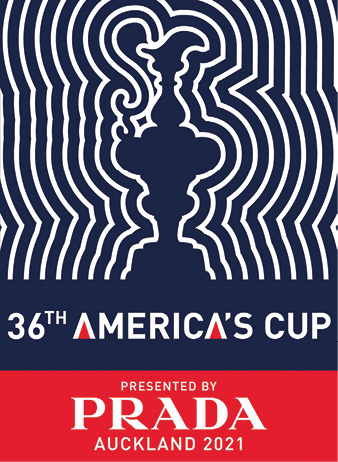
The competition will be fierce as three well-funded challenging teams from Italy, Great Britain and the United States of America will face off against an equally impressive home team from New Zealand.
In light of the world-wide pandemic which has affected us all, two previously scheduled America’s Cup World Series events were cancelled leaving the ACWS and Christmas Cup events the first times that the radical new foiling monohull America’s Cup Class were able to match up against each other and the results did not disappoint.
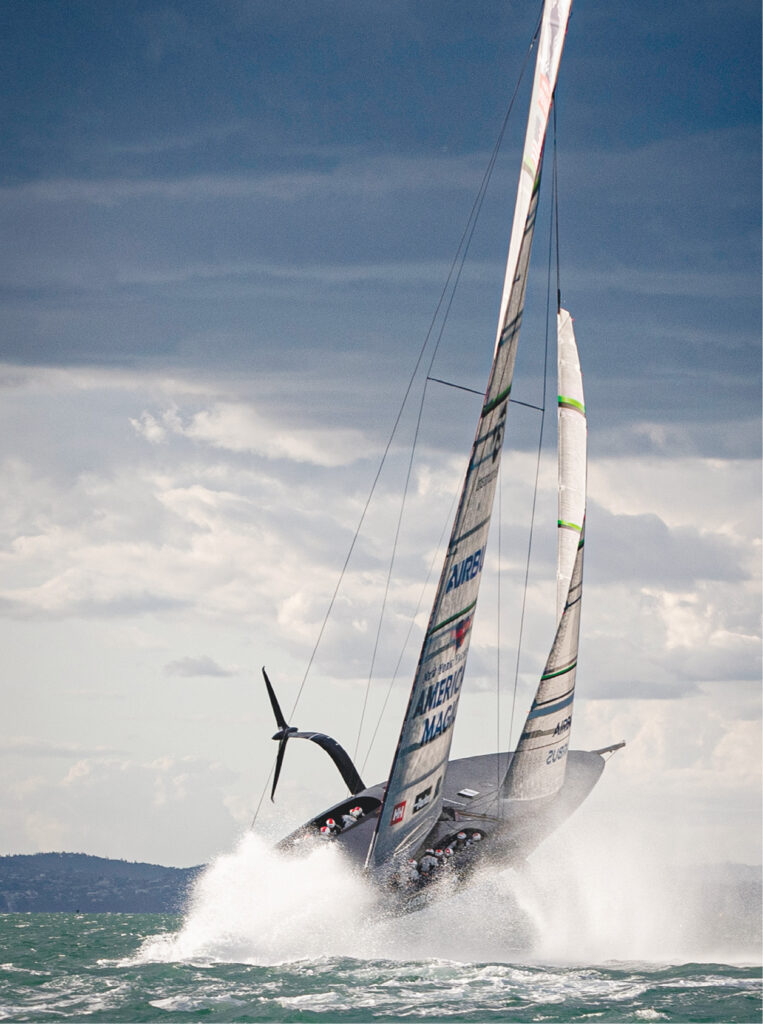
What we discovered early on is that when the winds come up these boats are extremely fast, particularly the Kiwis and blindingly unpredictable when the sophisticated software required to mechanize the foil arms experiences glitches and gremlins which can bring the boats to a grinding halt at any time. This can be excruciatingly frustrating for all concerned.
Just ask Sir Ben Ainslie and his English contingent. The INEOS Team UK led by Ainslie who, while commanding the attention of the Duchess of Cambridge, the vivacious Kate Middleton on more than one occasion in these Cup related events is currently stuck with a slow boat that won’t fly.
But on the other side of the spectrum the Emirates Team New Zealand (ETNZ) team has unofficially cracked the one-hundred-kilometer speed barrier according to multiple reports during a training day following the regatta.

The odometer allegedly read 103.7 kph which translates to 56 knots aboard Te Rehutai. The radical, possibly revolutionary speed demon which in Maori means, “Where the essence of the ocean invigorates and energizes our strength and determination,” showed all of that on and off the racecourse.
Whether it is all true or not is immaterial at this point. All the teams have their work cut out for them in the short weeks that lie ahead before the start of the Prada Cup elimination series set to commence on Jan 15.

What is known is the American Magic team representing the New York Yacht Club, the Luna Rossa Prada Pirelli team backed by the Il Circolo Vela Sicilia and the Royal New Zealand Yacht Squadron’s ETNZ are at least a step ahead of billionaire James Ratcliffe’s INEOS team which is banner backed by one of the oldest, most prestigious clubs in the world, the Royal Yacht Squadron.
The problems unfolded from the get-go as the foiled British couldn’t get their boat up. First BA (Ainslie) blamed the foil cant system software, which New Zealand who provided the designs vehemently denied (read below) and then it was one snafu after another as the Brits were depressed and buggered at this point during the whole bloody affair.

“We had problems before we even left the dock,” said Ainslie, who is the team’s skipper as well as its CEO. “We had to replace the foiling cant system before the race, and when we got to the course it still wasn’t working. It has been a problem from day one in this class, and all of the teams have been working to resolve it.”
“We were madly trying to fix the problem and then that ex had to jump off the boat and they kind of have fixed it. It is proprietary TNZ intellectual property. The foil cant system battery failed. The issue still hasn’t been resolved and we’re talking about a possible redress. This is supplied equipment and we’d like to call out Richard Slater (chief umpire) and the rules team to resolve it. This foil cant system problem is not solved and it was our problem today, but it could be easily somebody else’s problem tomorrow.”

Which led ETNZ and the America’s Cup Event (ACE) to quickly respond as follows:
“The foil cant system (FCS) is a one-design supplied component designed and developed by ACE for all competitors. It has been used since the inception of this class.
“All teams are responsible for the installation, ongoing maintenance and operating procedures of their own systems and the teams are provided with full operating and maintenance instructions and programs to ensure effective and reliable performance.”
For the past few months there has been a weekly coordinated call between all teams every Friday in an open and transparent environment to discuss the system and address any developments collectively. The maintenance and start up schedule that have been developed is a comprehensive schedule that is shared and in possession of all teams.
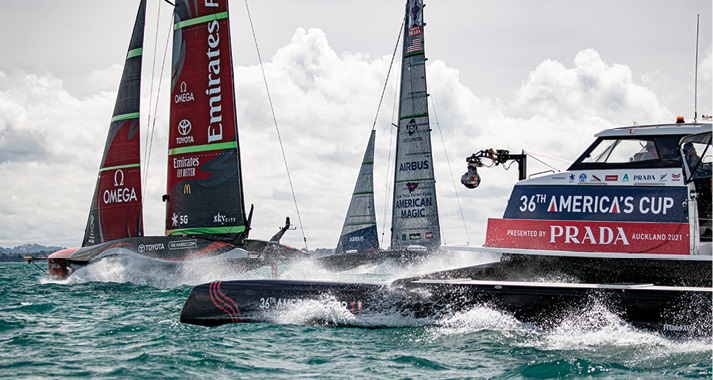
In ETNZ’s experience, if all maintenance and start up procedures are followed correctly, the system operates as designed and has no access system to ensure these procedures are followed by any of the teams.
In answer to INEOS Team UK’s suggestion that they “only received a software update at 12:00 p.m. yesterday? This is completely incorrect and inaccurate. The last software update was delivered to all teams last Friday following extensive consultation with them. Not midday yesterday.
As far as the Defender/Trustee is aware, INEOS Team UK’s FSC is fully operational.”
Ouch! That said, there is a measure of truth to the frustration the Brits are feeling as the whole launch of the AC75 class was delayed last year by several months due to multiple issues in the manufacturing of the systems in Italy. Designed by the Kiwis and built by the Italians, what could possibly go wrong? Right!
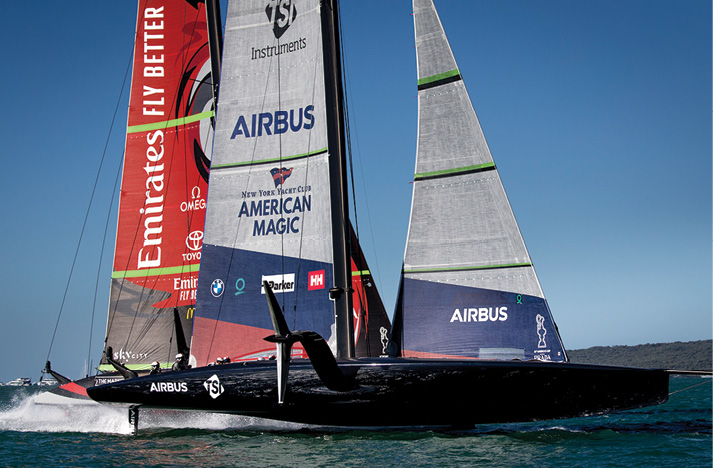
Anyway, the INEOS team managed to get back on the racecourse for the remaining races, but their performance was far from perfect.
The actual ACWS ended up pretty cool. The new boats are amazing to watch when they are up and foiling, but when they come splashing, crashing down it is an ugly affair indeed. The area of racing combined with the Kiwi summer can be tantalizingly frustrating as we say in the prolonged America’s Cup affair in 2003 when racing was interrupted on multiple occasions by either too much or too little wind.
2021 will probably prove no different as the wind holes on a patchy racetrack which drop the flashy new boats off their foils and leave them languishing like dead ducks makes for a boring spectacle and nascent television to say the least. Speaking of television…
“Set against the picturesque background of the Hauraki Gulf,” their words, each AC75 is equipped with ten cameras supplemented by chase boat, helicopter and drone cameras. Coverage will include the world feed with commentary from North Sails President Ken Read (excellent) and newcomer Stephen McIvor, together with Olympic gold medalist Shirley Robertson and SailGP catamaran sailor, Nathan Outteridge, who provided excellent analytics.
What it means in America is that you a have few options, but many choices. NBC was awarded the TV rights here. At what cost? Don’t ask, won’t tell. NBC has farmed live coverage to its sports ap NBC Gold with a $175.00 price tag for the four months. NBC Sports will air a tape delayed broadcast, generally a few hours after the finish of the earlier races.
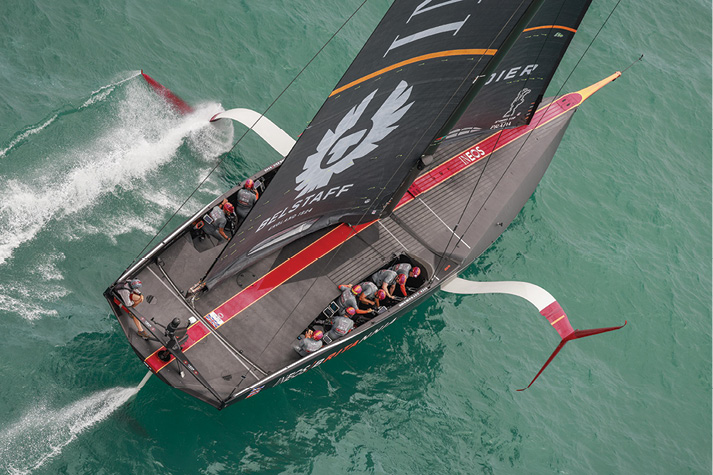
The latter runs in the wee hours of the morning, yes even on the West Coast. Auckland time is 15 hours ahead of San Francisco.
If you don’t want to pony up to folks at Rockefeller Plaza in New York City to watch live, you can get yourselves a VPN number which projects your device’s presence outside the territorial reach of broadcast police, and in another country like Sweden for just a few bucks a month and then you can view it on YouTube. Hence the conundrum. Your choice.
For me, I am still working on getting my butt down there. With COVID-19, it ain’t easy and I think if I do get down there, I might just stay; get myself a cozy little bungalow in Hobbiton. Ha ha, just kidding, but I have been classified as an “essential worker” by the New Zealand Government and I do have a huge crush on their PM!
Anyway, back to reality.
The format for the Auckland ACWS went as follows. Three days of four one on one match races between the four teams. No fleet racing as of yet with the blazing fast and unpredictable AC75’s. The inherent dangers are obvious and if the boat’s complex systems lock up, a wayward foiling monohull could present itself as a danger to those on the racecourse and the spectator fleet.
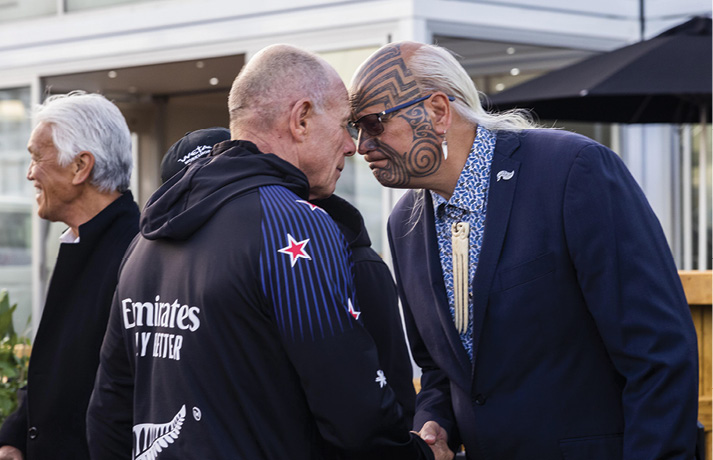
The Teams
The teams are formidable.
ETNZ, which craved home field advantage for years, now has it again and they bring an experienced team on and off the water. Led by CEO Grant Dalton, who can be an advantageous bulldog, is never to be underestimated. He has had a rocky road the last few months with internal audits combined with government and media scrutiny, leaving him in no mood to be fooled with.
Dalton took over the team after the disastrous 2003 defense which left New Zealand “Cupless” and in turmoil. No one was better suited than Dalton to pick up the pieces and put them together again.
The sailing guys are led by Peter Burling who helmed the bicycle powered AC50 in Bermuda, which propelled them to victory by crushing OTUSA in nine races. On board is Glenn Ashby who is the skipper and wing(sail) trimmer. Blair Tuke at the flight controls and a host of grinders generating with their arms this time a ton of hydraulic power in order to operate the monstrous foiling arms. Needless to say, there are a lot of buttons to push!

They are coached again by their legendary tactician, Ray Davies.
The design team, which created the Class Rule is led by Dan Bernasconi. The syndicate principal is Mateo De Nora and a host of corporate sponsors which colorfully adorn the hull and sails, including of all companies, the golden arches of McDonald’s. (If the water flows backwards down under are the Big Macs made upside down?)
Te Aihe (Boat One) is joined by its radical looking (ugly) sister Te Retuhai (Boat Two).
Don’t underestimate the Kiwis in any respect. This event is in their backyard and they aren’t about to give up the America’s Cup without a street fight. Burling is being critiqued again on languishing in the starting box, and then relying on his boat’s blazing speed to close the gap on the subsequent legs. But that is a ruse. Young, old Pete knows exactly what he is doing, just like when he lured OTUSA and Tom Slingsby in the same trap three years ago.
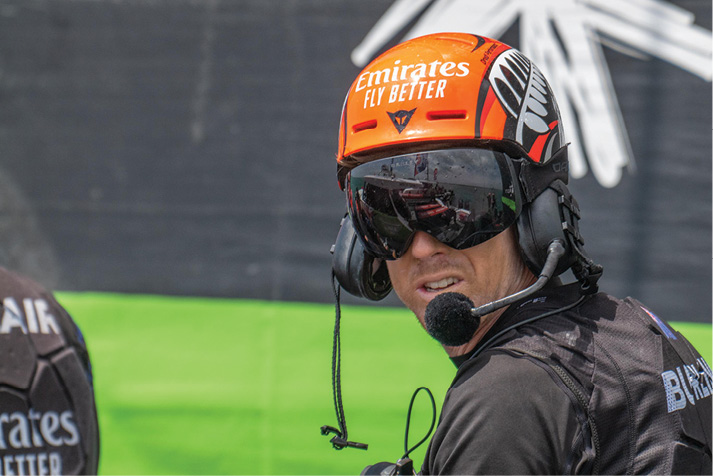
The Americans are led this time by Terry Hutchinson. They are a well-organized no-nonsense bunch this time around and with the financial backing of Roger Penske, Doug DeVos and Hap Fauth, don’t expect the miscues and pratfalls of the New York Yacht Club’s previous efforts since they relinquished the Auld Mug almost 40 years ago.
The racing team is led by Dean Barker who is as experienced as they come in this game, having skippered Team New Zealand into three America’s Cup finals and leading Soft Bank Japan last time.
Joining him in the afterguard is Andrew Campbell ex OTUSA on flight control, and Paul Goodison from Land Rover BAR last time along with seven other hefty souls to grind it out.
They promise to bring the America’s Cup home to Newport, Rhode Island with some American “magic.” Let’s hope so! Nothing would be finer than having the gleaming, ship-shine affair back at Breton’s Reef on Narragansett Bay.
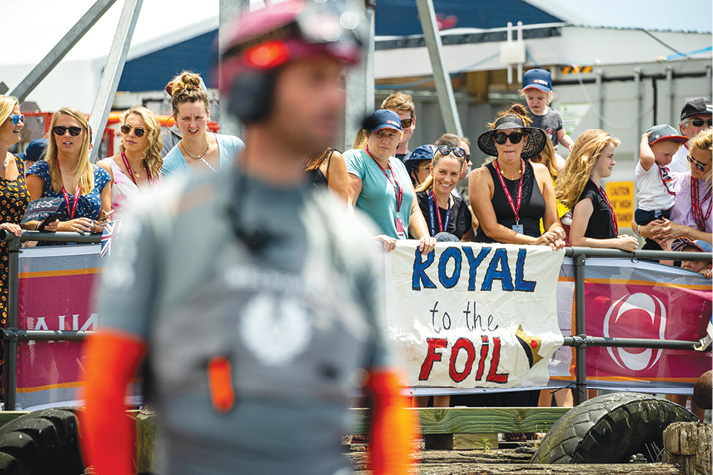
The team has produced two interestingly shaped and fast AC75’s in Defiant (Boat One) and Patriot (Boat Two) designed by Marcelino Botin and built in Rhode Island at a dedicated construction facility in Bristol.
“There is no better place to build world-class racing boats than in Rhode Island with its unmatched marine industry, skilled workforce and rich America’s Cup heritage,” said Hap Fauth (Naples, Fla.), Team Principal and CEO of American Magic.
Fauth has built three highly successful Maxi racing yachts at New England Boatworks (NEB) in Portsmouth, which all share the name Bella Mente.
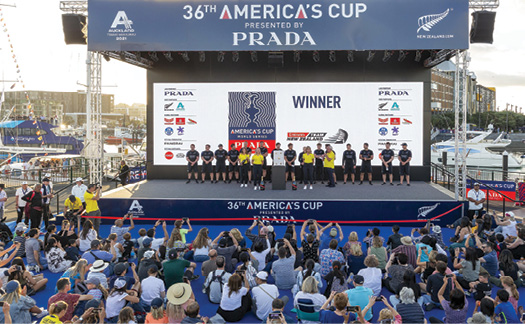
“Rhode Island has long been a global center of composite technology innovation, and our new America’s Cup team is pleased to add to an amazing legacy that began well over a century ago,” said Fauth.
Rhode Island’s Herreshoff Manufacturing Company (1878-1945) built their first America’s Cup “defender” yacht, Vigilant in Bristol during the winter of 1892/1893. This was the first in a long line of boats that defended the America’s Cup between 1893 and 1934, designed by legendary Rhode Island Naval Architects Nathanael Greene Herreshoff and Starling Burgess.
Many other America’s Cup defending and challenging boats were also built in the area, including a series of boats constructed by Goetz Composites in Bristol and by New England Boatworks.
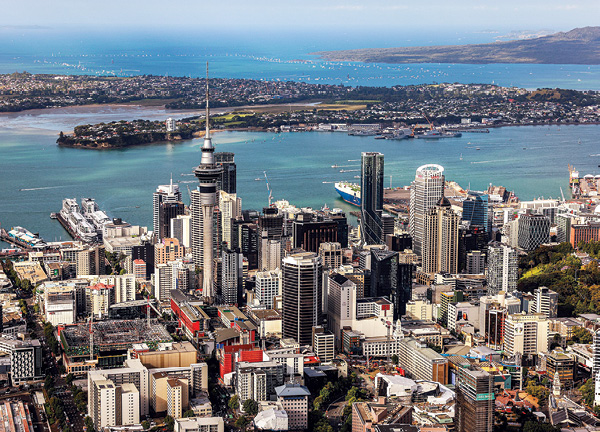
American Magic brings together two highly successful racing programs with one of the foremost yacht clubs in the world, united by a campaign to win back the Cup, reconnect the American sailing base with the premier event in the sport and elevate the quality of competitive sailing in the United States.
The name, American Magic, is a nod to the New York Yacht Club’s storied America’s Cup history; a combination of the boat the trophy is named for, and the first boat to defend it.
“We’re finally here, racing is set, and it seems like yesterday that we started on this adventure,” said Fauth. “Thank you all for your blood, sweat and long days. Treat the racing as ‘business as usual.’”
ACW’s Auckland comes after the two prior exhibition events, ACW’s Cagliari and ACW’s Portsmouth, were canceled due to COVID-19.
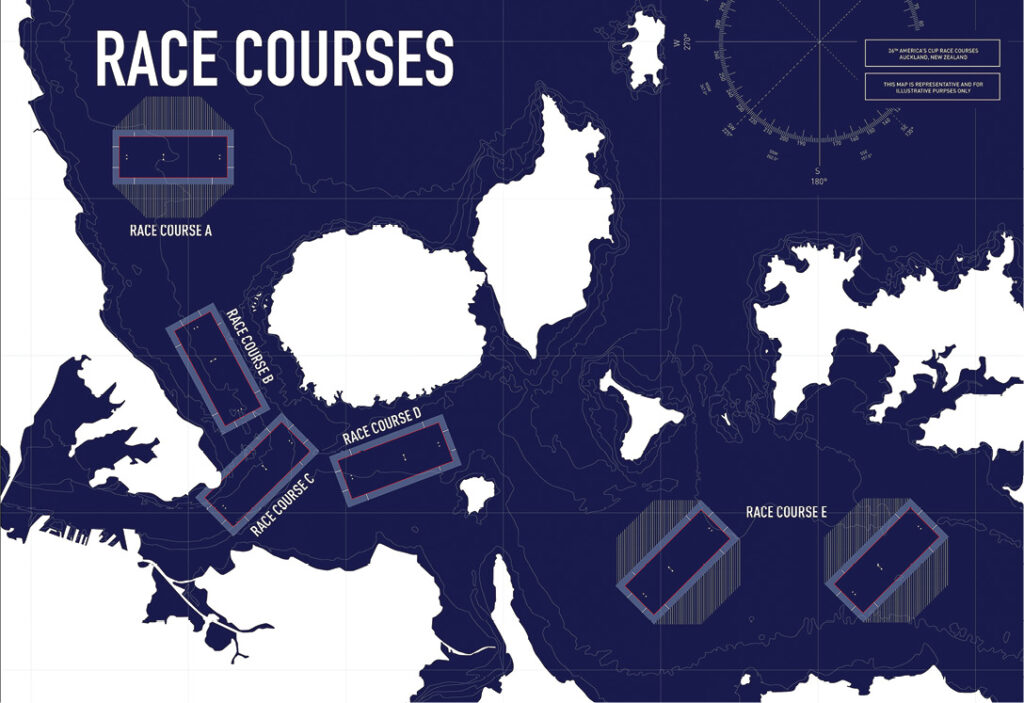
“In terms of not having the opportunity to race in Cagliari and Portsmouth, from the systems that go inside the boat, to the media (camera setup onboard the boats), to the race committee, we all are probably a bit on the back foot,” said Hutchinson.
Despite the new Cup class and the many new technologies implemented into the race management program for Auckland, Hutchinson said one thing that stood out to him was the quality of the competition.
Despite the onset of long-awaited AC75 racing, the COVID-19 pandemic remains very much on the minds of American Magic team personnel. Team members went through New Zealand’s rigorous managed isolation process and left many families and friends back home.
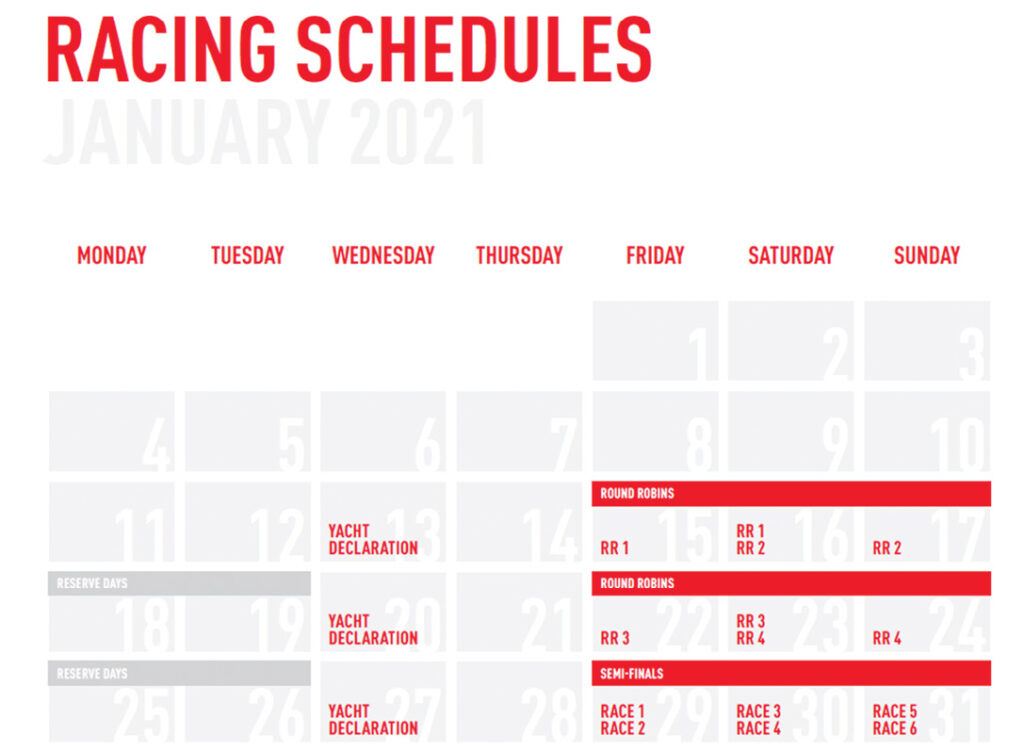
“We feel very lucky to be here in New Zealand as a team,” said Hutchinson. “We were incredibly appreciative of the work and the effort that went on behind the scenes to get us here. We put all of our gear on a boat in Pensacola, Florida (in May) with really no guarantees as to when we could get into the country. And as it all played out, it all worked.”
American Magic’s Official Innovation Partner is Airbus and their sponsoring Club is the NYYC which was founded in 1844 when nine New York yachtsmen met aboard John Cox Stevens’ yacht.
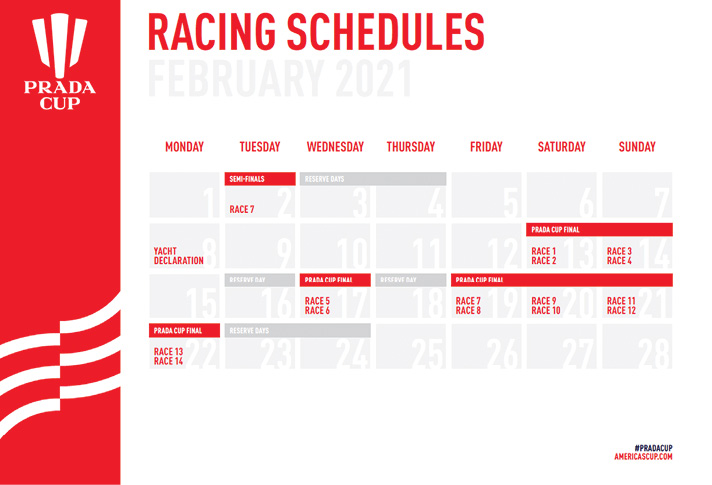
The Club maintains two exquisite clubhouses, on 44th Street in the heart of New York City, known for its Model Room and extensive nautical library, and Harbor Court in Newport, RI.
This brings us to the Challenger of Record (CoR), the Italians. They bring back Jimmy Spithill this time, who needs no introduction. Spithill lead OTUSA to wins in 2010 and 2013 before it all came crashing down in Bermuda three years ago, in many ways to no fault of his own.
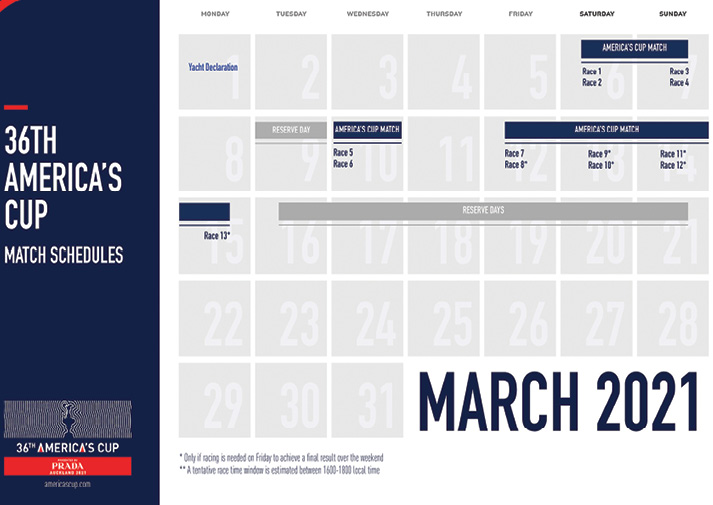
He is blindingly fast, aggressive, smart and is great for the event, much like Helio Castroneves is for IndyCar.
Joining him in the afterguard is Francesco Bruni at co-helm. The Italian boat has twin helmsmen, which is kind of like a car with twin steering wheels! We’ll see how that works! The team is led by Max Sirena.
The Luna Rossa Prada Pirelli team has built two new AC75’s which to the naked eye appear identical, but don’t be tricked. The Italians have been at this a long time and many would say their due and the reception back home would be insane! The worst thing in the world wouldn’t be having the America’s Cup back in Europe.
The team’s base is Caligari, Sardinia Italy. The design is led by Horacio Carabelli and the Syndicate Principal is Prada boss Patrizio Bertelli.
Spithill shared some of his thoughts recently in remarking that, “old style match racing you need both speeds; you can’t match race a slow boat against a fast boat and expect to win. There is a heap of boat speed left.”
“We have the advantage of racing in the Prada Cup, which ETNZ doesn’t,” said Spithill, who recently signed on the American Team for SailGP. “You are always going to be pushed harder when you are actually racing another boat as opposed to when you’re out there training and testing on your own.”
As far as the twin helm, “I only stay on one side, so I only get to see half the racetrack really. Everything happens really fast with these boats which is similar to the last boat we were in. It is definitely more compacted than before. We are all in a trench style cockpit. The G forces are right up there.”
Which leads us back to the British. The INEOS Team UK with Britannia 1 and Britannia 2 which were designed and engineered in part by Mercedes F1 team, though the actual program is led by Nick Holroyd and Juan Villa.
The back of the boat brings a wealth of experience to assist Ainslie with Ben Cornish, David Carr, Giles Scott, Nick Hutton and from the Ocean Race background is Xavier Fernandez.
Ainslie experienced victory as tactician in 2013 on OTUSA but has struggled since. He also brings four Olympic Gold Medals to the table and a silver, plus he has the Queen to be faith and support. Watch out!
The design program which has come under fire, features an odd shaped radical bustle as part of a water skimming-aero inflecting hull shape which potentially takes advantage, strangely enough for a yacht, ground effects.
The ACWS And Christmas… less Cup
As for the ACWS action it was interesting, fascinating, jaw-dropping and WTF, but definitely worth the wait as we recap some of the best moments and highlights!
As for the American Magic team, they are absolutely on pace and after splitting with both the Kiwis and Italians, their two losses were due to “technical” issues rather than gybes and tacks going the wrong way.
The post-race focus for all four teams is centered on a deeper evaluation of the racing held during the previous events.
For American Magic, the ACWS represented a learning opportunity that will have a profound impact on how the U.S. Challenger chooses to use its remaining development time.
“Each opportunity you get to sail against another team presents challenges and problems that you see in your shop,” said Hutchinson. “We’ll go out (sailing) and try to answer some of those (issues in practice).”
“You look around the fleet and there’s a lot of really good ideas on the other boats,” said Hutchinson, who is now deep into his fifth career Cup campaign. “It’s good to see that some of our ideas seem to be working. At the same time, we may grab on to a couple of others that we can implement into our own sails or techniques.”
American Magic closed out racing at the first AC75 class regatta with a second-place finish overall. ETNZ, won two of its races against American Magic and the Luna Rossa Prada Pirelli Team to claim the top spot.
American Magic led ETNZ for the first half of Race 10, with a chance to claim a regatta victory with a win. However, with the race a dead heat approaching the end of leg 3, Patriot fell off her foils during a light-air tack. This allowed ETNZ to build and defend a sizable lead for the rest of the race.
“When you drop off a foil, it’s sort of game over,” said Dean Barker, Helmsman for American Magic, who explained at the post-race press conference that technical issues with the port-side foil were the cause. “These boats are challenging in the bottom wind range to just keep foiling 100 percent of the time.”
American Magic also raced and won against INEOS Team UK, giving the U.S. team a 4-2 overall record for the event.
In the first race with the Kiwis, they entered slowly and didn’t seem to want to engage with the Yanks. New Zealand looked slow and American Magic charged into the line at speed and on time and well ahead of ETNZ whose crew comms suggested a technical problem.
But as the pair got underway, both boats were running at 32 to 35 knots upwind. American Magic was to the left of the course with ETNZ underneath as American Magic protected their position up the beat. At the first windward gate Patriot rounded 0:15 ahead as they screamed downwind, which seems to be the AM team’s sweet spot to the right-hand boundary of the course.
This was already the closest race of the day.
As the gusts swept across the racecourse, the Kiwis on Te Retuhai were able to sail deeper at times as they took a more direct route to the bottom gate. But doing this meant putting in a few more gybes in the process, negating any advantage they had gained.
By the bottom gate, the home team was 17 seconds behind as they rounded the same left-hand mark on the course as American Magic.
By the second windward gate, American Magic had stretched their advantage to 0:26. But while the distance had grown on the second upwind leg, Emirates Team New Zealand gradually hauled back a few seconds to pass through the bottom gate 0:20 behind.
Choosing the left-hand mark allowed them to take the opposite side of the course before then instigating a tacking duel. This eroded the Americans advantage as the Kiwis were now executing better tacks between the two.
By the windward gate, the margin had reduced and American Magic still had the advantage but only just and they were being pushed hard. But at the left-hand mark at the final upwind gate Te Retuhai got to the zone first and gained rights over American Magic to round inside and ahead. A protest was dealt to the Americans and cleared shortly afterwards.
“It was a very quick penalty on penalty off,” said Chief Umpire Richard Slater.
Meanwhile, Burling on Te Retuhai gybed quickly but was in less wind, and when the pair came back together American Magic had regained their lead and had engineered a better approach to the finish to take the win!
“We have a lot to learn to beat ETNZ on a regular basis,” said Patriot flight controller Andrew Campbell. “You would like to come off the racetrack with wins. So, to see our fans super excited to put up two wins today is worth every penny. There was a lot on course. It is a long skinny track; we went through a lot of maneuvers so we put a high priority on keeping the boat dry.
“The reality is that we have so much to learn between now and the Prada Cup,” said Campbell. “Watching how some of these other races went, it’s really, really impressive what we still need to figure out. I know there are some big mistakes we made on the racetrack that we need to correct.”
The Italians were up next for the American Team.
The four match races of the day were held on Course C, the preferred playing field as it brings the racing right into the heart of the Waitemata Harbor with shifty and puffy Northwest breezes between 10 and 14 knots.
“Racecourse C is the signature course for these boats where the people want them, and it is a treat for all of us,” said Race Director Ian Murray. “They (the boats) are incredibly fast, spectacular and they burn up a lot of racecourse. We’re trying to put them, the courses and the boats where the people would like to see them and to have them and to put a good show on.” Luna Rossa enters the box early on starboard tack, immediately taking a penalty which, the team takes in stride thanks to an excellent starting speed at the left of the field. In the first upwind, a bad tacking maneuver keeps the Americans at a standstill for a few seconds, allowing Luna Rossa to increase her lead.
Throughout the race, the Americans managed to recover some of their delay and get back into the race, proving an excellent speed, especially on the downwind legs as they forced Luna Rossa into a tacking duel to defend the lead. Luna Rossa Prada Pirelli kept the lead for all four laps, crossing the finish line with an advantage of 12 seconds.
“There were a couple of areas on the course where it was a little bit of a minefield out there and you had to work hard to connect the dots,” said Spithill. “I think it was just a little patchy out there when asked about whether the minimum wind limits (6.5 knots) were too low. It is important to perform those maneuvers in pressure rather than a light spot.”
“We had a nice position,” said American Magic Skipper Barker. “It dropped off the foil and it was game over. We had two issues with the same foil and it obviously is frustrating when it doesn’t all go to plan. If you have to blame, blame the boat! It put us on our back foot, but there were a lot of positives out of it.”
The return match between American Magic and Luna Rossa Prada Pirelli was the third race of the day. The breeze had shifted further to the left and the course had been adjusted to match with four laps.
On the entry into the start box, Luna Rossa Prada Pirelli came in early and were dealt a penalty. Two starts, two penalties so far, but there was more to come.
American Magic was leading and headed out towards the left-hand side of the course. By the time they reached the windward gate it was clear that they had chosen the better side of the course and rounded 0.21 seconds ahead of the Italians.
Little had changed in the distance between the two by the first leeward gate with both boats taking the left-hand mark, 0.20 seconds apart. On the water the distance was around 140 meters.
This time American Magic seemed keener to cover their opponent, matching them tack for tack to protect their lead with good reason.
At the second windward gate Luna Rossa Prada Pirelli had cut the deficit in two to round 0.10 seconds behind.
By the bottom of the downwind leg, the distance had increased a little to 0.14 seconds as the Italians performed a perfectly executed starboard mark rounding that rolled into a tack as if they were on rails.
Once again, Luna Rossa Prada Pirelli had gained upwind to close the gap to just five seconds. By the end of the third lap the distance had grown once again to 0.15 seconds. A pattern was starting to appear with Luna Rossa Prada Pirelli faster upwind, American Magic quicker downwind.
A pattern in the tactics was appearing too with another very similar pattern of play on the final upwind leg as American Magic matched Luna Rossa Prada Pirelli tack for tack to protect their lead. And this time, protect it they did as the Americans rounded the windward mark for the final time 0.16 seconds ahead and comfortably covered to finish and win by 0.30 seconds.
“The pre-start was a bit like the old-school days,” said Barker. “There was quite a lot going on, as normal. It’s what we’ve been practicing, but in saying that it’s nice to have a bit of variation. This is all about learning for the Prada Cup and it’s nice to learn some of these lessons now. The course is very challenging. You are never quite sure how much leverage to take, but they never went away and made it a very exciting race.”
In the penultimate rematch of the series ETNZ and American Magic came into the start box and neither seemed keen to engage in a pre-start duel. Indeed, as the clock counted down to the start itself Te Retuhai was at the pin end of the line while Patriot was at the committee boat end. Both were at speed and on starboard. When the pair came back together after the Kiwis had tacked onto port, the Americans used the starboard tactical advantage that they had to tack in front of Emirates Team New Zealand. Advantage American Magic. Eventually the Kiwis tacked away, unable and unwilling to live in the dirty air of the Americans, who were able to continue to work the right-hand side of the course, handing them a slight further advantage but the margin was still slim. Meanwhile, ETNZ fluffed a tack momentarily and splashed down, slowing them in the process, all of which helped to hand American Magic a few more meters.
By the top gate on the first lap, American Magic took the right-hand mark to lead ETNZ by 0.12 seconds. But by the bottom mark Emirates Team New Zealand had hauled American Magic in to trail by just 0.03 seconds as they went through the leeward gate. The big race changing moment was to come at the top of the second beat when the Americans fell off their foils through a tack and parked up just short of the windward gate. The mistake proved costly, handing the lead to the Kiwis who rounded the windward mark 0.54 seconds ahead. From there the Kiwis cruised to victory, sailing the final lap unchallenged to win by 1.19 seconds.
“We learned where Patriot stands against the fleet, which we didn’t know before,” said Hutchinson. “You are always analyzing and comparing what you have versus the three other teams.”
There was everything to play for in this last race of the scheduled regatta, and the show between the Kiwis and Italians didn’t disappoint.
At the start, Luna Rossa Prada Pirelli showed their intent by performing a perfect port tack shortly after forcing ETNZ down into an area of the start zone nicknamed “coffin corner” by the sailors. It certainly was for Peter Burling who was forced to follow the Italians lead who were already over 200 meters ahead. By the first gate, Luna Rossa Prada Pirelli were ahead by 0.32 seconds. But the margin was about to grow quickly as ETNZ pinched around the top mark and came off their foils in the process. Struggling to get back up to speed saw the margin grow to 800 meters. Shortly afterwards, Luna Rossa Prada Pirelli splashed down as well. With both boats off their foils, the match was now a race about who could take off. Here it was ETNZ who took flight first, doubling their speed over Luna Rossa Prada Pirelli, 24 to 12 knots respectively.
But the news for the Italians was about to get even worse as the Kiwis stayed with their breeze to sail at 29 knots, while Luna Rossa Prada Pirelli struggled to break 15 knots and stay on their foils. Through the bottom gate, ETNZ was clearly in the lead. The race had been shortened but there was still another lap to go – every reason for the Italians to keep the pressure on. Minutes later ETNZ performed a poor tack and fell off their foils and slowed down, allowing Luna Rossa Prada Pirelli to haul back up into contention.
By the last gate rounding there were .18 seconds between the pair as Burling headed down the right and Luna Rossa Prada Pirelli down the left.
The difficulty in pulling off clean gybes was clear to see; at one point the margin had grown to over 300 meters. But by the finish it was the Kiwis that had held their lead to finish 16 seconds ahead of the Italians and in doing so, win the PRADA America’s Cup World Series.
“We were pretty nervous when the breeze dropped into the six-knot region and we fell off the foils,” said Emirates Team New Zealand’s flight controller Blair Tuke, “but it’s been an epic day’s racing.”
There was no wind for the Christmas Race and there is certainly much to analyze for the teams. Racing got underway on time, a start in eight to nine knots, more than enough breeze for the AC75’s to get up on their foils and fly into the prestart. INEOS Team UK entered on port and could not cross ETNZ as the Kiwis allowed them to sail across the face of the start line before engaging in their final approach to the start.
Both helmsmen, Burling and Ainslie were more interested in staying on their foils and preserving their speed than engaging in any prestart arm wrestling. A slight drop in pressure saw both boats late for the line, well back for the start at the gun. ETNZ on the right just managed to lay the leeward end of the line, but INEOS Team UK could not, and tacking onto starboard struggled with momentum, falling of the foils and handing the Kiwis a clear advantage.
It was an uphill battle from there for the British, crossing the right-hand boundary and getting a penalty which only compounded their misery.
Without looking back, ETNZ were up and off, but also against the clock to beat the 45-minute race cut off time to the finish.
The clock won the race, and the race was terminated with ETNZ just a few hundred meters from the line.
ETNZ flight controller Blair Tuke remained positive despite the outcome. “To begin with it was all good. We had a good start, and were sailing the boat nicely in some really light wind and don’t forget that every second we race these boats we are gathering valuable data. Sadly, in the end it dropped off a bit earlier than expected and we had to low ride all the way down wind. Gutted not to make the time limit – but plenty of positives and valuable lessons learned.”
“All the boats stopped, some more than others!” chimed in Ainslie. “The issue is when the wind goes below the wind limit of six and a half knots during the race,” said Iain Murray. “We have a rule that has been in place in San Francisco.”
“It shows how hard it is to sail these boats at the lower end of the wind range,” said Burling.
The Race Committee finally called it a day and the last possibility to see the AC75’s racing was over for this year as it was a one-day event with no reserve days.
ETNZ will have more time to develop their boat compared to the Challengers prior to the 36th America’s Cup Match Presented by Prada. The Cup match between ETNZ and the Prada Cup winner begins on March 6, 2021.
Thank you to the America’s Cup Media Center for their contributions to the report.
Hopefully I will be there to report in person! Keep your fingers crossed. Chow for now. mark@yachtsmanmagazine.com
Thanks for checking in! mark@yachtsmanmagazine.com



